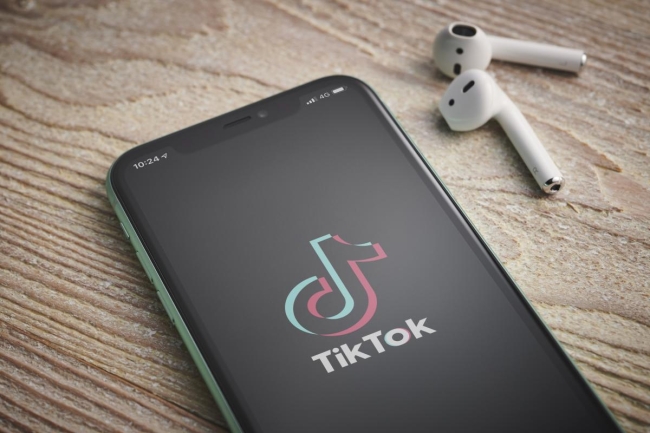You have /5 articles left.
Sign up for a free account or log in.

Phil Barker/Future Publishing/Getty Images
Liz Sawyer, a student ambassador for Cape Fear Community College, dances in front of a brick pathway on the Wilmington, N.C., campus, a trending TikTok mash-up song playing in the background.
In front of her, a text bubble reads, “Why did I choose my community college to become a dental hygienist?” punctuated by an emoji of a tooth. Answers pop up on the screen in white bubble letters: smaller class sizes, accredited courses, caring faculty and staff.
The 13-second video on Cape Fear Community College’s TikTok account has over 95,000 views, 6,000 likes and 130 comments. It’s been shared 82 times. And that’s not even the college's most-watched post. One video on community college stigma garnered over a million views in September 2020, two months after the college started its TikTok account.
“That video totally went viral,” said Julie Martin, marketing and communication specialist at Cape Fear. “That was the first video where it was like, this is actually working. This is reaching a lot of people.”
Now the account is teeming with videos of students, faculty members and staff members dancing while highlighting specific programs or listing the advantages of an affordable community college degree.
“We just really wanted to show students the fun side of our campus,” Martin said. “To have an adviser doing a dance on social media, you don’t see that a lot. People really seem to like the fun side, the lighter side.”
The past academic year has felt anything but light as the COVID-19 pandemic closed campuses and shifted courses online. Enrollment fell at colleges across the country as students wrestled with the mounting challenges of the pandemic and its accompanying economic downturn -- lost jobs, sick family members and the hurdles of adjusting to online learning. Enrollment drops were particularly steep at community colleges, with total undergraduate enrollment across the sector falling by 11.3 percent this spring compared to last, according to the latest National Student Clearinghouse Research Center data. Meanwhile, the COVID-19 pandemic stymied some of the more traditional methods colleges use to recruit students, such as high school visits.
Against that backdrop, TikTok, known for its emotive facial expressions, funny memes and upbeat dance clips, seemed worth a shot as a tool to engage prospective students. Cape Fear's enrollment ultimately did not decrease in fall 2020. In fact, the number of students in fall semester courses rose a little over 1 percent compared to the previous year, and Sonya Johnson, executive director of marketing and community relations, partly attributes that to the institution’s social media efforts.
“It was kind of the perfect year to launch this,” said Johnson. TikTok is a way to “meet students where they are -- on their phones.”
As one of the student ambassadors producing the videos, Sawyer said her goal is to show students what real life at Cape Fear looks like. Her videos show her on campus, sometimes in her scrubs. She shares details about the application process and prerequisites for her dental hygiene program. She does dances accompanied by text bubbles about how excited she is to be graduating in July.
“Most of my videos have been on my personal educational journey,” she said. “I think it’s really put a lot of ideas in people’s head that they can really pursue goals and go to community college and be successful.”
The platform is a good place to reach traditional-age students, especially women, said Jamie Wagner, executive director of Media Prefs, an arm of Interact Communications, a marketing firm for two-year colleges. The firm surveys students about their social media habits to help community colleges target advertising to prospective students.
A Media Prefs survey of about 62,000 college students across 37 states this academic year found that TikTok was the fourth most popular social media platform, outranking Twitter and Snapchat. But among women ages 18 to 20, TikTok was especially popular. The site jumped from their fifth-favorite platform last spring to their most favorite platform this year.
“If a college is focusing a lot of time promoting on Twitter as a place to reach potential students, and they don’t have a TikTok account, now may be the time to start readjusting strategy, especially if they want to hit some of those younger demographics,” Wagner said.
Cape Fear wasn’t the only community college to branch into TikTok during the pandemic. Others, including the Community College of Philadelphia, Calhoun Community College in Alabama, Northern Virginia Community College and Meridian Community College in Mississippi, all posted their first videos in 2020.
“By the summer of last year, we knew we were facing unusual circumstances with the virus, so we wanted to take advantage of every opportunity available to reach potential students,” said Wes Torain, director of public relations and digital media at Calhoun Community College. “We know it's important to target our marketing to where our students are. If they're on TikTok, then TikTok is where we will be as well.”
At Calhoun, enrollment dropped from 9,315 students in fall 2019 to 8,278 students in fall 2020. To reach prospective students, the college’s public relations team and recruiting team meet regularly to brainstorm TikTok videos. Right now, the group is working on a series to highlight 15 different academic disciplines offered at the college.
“We have about 30 seconds or less to get our message across,” Torain said. “What we attempt to do is say, ‘At Calhoun Community College, you can get ahead, save money, graduate early. Register now.’ That’s the message.”
Four-year institutions have been experimenting with marketing on TikTok for a while now, but community colleges don’t always have the capacity, said Alisa Berry, social media specialist at Northern Virginia Community College. Berry started a TikTok account for her college four months ago. Right now, she's basically a one-woman TikTok film team, with help from students and staff willing to star in the videos.
Nonetheless, Berry finds the platform, even in its infancy, a useful tool -- not just for marketing but for communicating information to the student body as students take courses remotely. The college’s profile features TikTok videos encouraging students to get vaccinated, outlining social distancing guidelines and reminding them of scholarship deadlines.
Berry expects the number of community colleges using TikTok to grow.
“I think it’s definitely something that’s on the up and up,” she said. “Individuals at different universities, within their bandwidth, and community colleges, they’re going to start utilizing it more.”
A few institutions have already approached Cape Fear for advice on how to start up their own TikTok accounts.
One of the main advantages of the platform for colleges is the personal touch of having “peers looking to their peers,” said Erin Fabian, the college’s digital marketing analyst. When Cape Fear posts a TikTok video, she sees a spike in visits to the college’s website, and she thinks that dialogue between students is partly why the platform is so potent.
“It eliminated the institution from the communication,” she said. “It kind of was just student to student, student to prospective student, and it made students feel more comfortable and excited to watch those things. It eliminated that gap, that barrier.”








